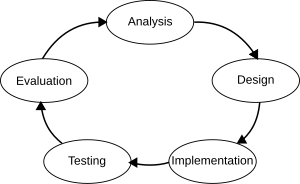Systematic approach to problem solving: The cycle
When creating software, hardware, or any kind of product you will go through several stages, we define these stages in the System Development Life Cycle. There are many other models out there that you might be interested in learning more about, but for this course we are going to learn the model shown below.

Any System Development Life Cycle should result in a high quality system that meets or exceeds customer expectations, is finished within time and cost limits, works effectively and efficiently and is inexpensive to maintain and cost-effective to improve upon. For this chapter we are going to look at how a computer games firm, 'Electronic Crafts', would look at making a new computer game.
Cycle
[edit | edit source]As this is called the Systems Development Life Cycle, it's quite usual that a company will then go back to the analysis once it has evaluated a product. Think about some of the software products that you use, they probably have a version number or a year, and reuse code and designs from previous years
- Windows 95 -> Windows 98 -> Windows ME -> Windows XP -> Windows Vista -> Windows 7 -> Windows 8 -> Windows 8.1 -> Windows 10
- FIFA International Soccer -> FIFA Soccer 95 -> FIFA Soccer 96 -> FIFA 97 -> FIFA Road to the World Cup 98 -> FIFA 99 -> FIFA 2000 -> etc.
With the Systems Development Life Cycle, you never just quit, you are always looking at ways to improve or surpass what you have created.
